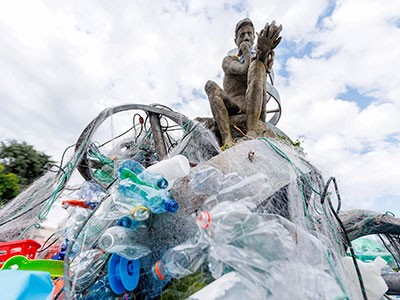When United Nations talks on plastic pollution collapsed in Geneva, Switzerland, in August, observers said the outcome had been an abject failure and the process had collapsed. Earlier this month it was reported that the chairman of the negotiations, Ambassador Luis Vaias Valdivieso, would step down. deep uncertainty.
Trust and science: important elements missing from plastics deal negotiations
Many media outlets saw the failure of multilateralism, but what I saw was fatigue. Just as the “failed” 2009 Copenhagen climate summit paved the way for the 2015 Paris Agreement, this violation of the plastic contract could be a game changer – if we learn the right lessons and rethink the process.
As a researcher of global environmental governance, I have followed the negotiations from the beginning. I was an advisor to the Rwandan delegation in 2022 when it co-sponsored a UN Environment Assembly resolution to stop plastic pollution. As of 2023, I am leading the observer delegation at Northeastern University in Boston, Massachusetts. During this time, I watched as countries debated the scope of the treaty, repeating positions without much progress. But people from every country tried to maintain faith in this process.
The negotiations stalled in part because a false morality play of ambition and obstruction had begun. Over the years, I have witnessed how the “heroes versus villains” narrative has obscured the complex realities at stake.
But the story is never that simple. From the start, countries have disagreed about what it means to end plastic pollution. For some, it was about improving waste management, recycling systems and the circular economy. For others, this meant limiting the production of virgin polymers. This ambiguity led to geopolitical rifts. For some countries, plastic production is the basis for economic survival and political stability. For small island states and vulnerable coastal areas, plastic pollution threatens human survival. However, each country must protect its ecosystems.
Environmental agreements paralyzed: here's how we can do better
Despite clear science and growing public pressure, negotiations have become bogged down in the politics of survival – between countries concerned about economic realities and those most affected by environmental problems. I spoke with Vaias Valdivieso, who reflected on “the scale of the negotiations, given the environmental, health and economic implications.” Concluding a treaty that would touch every country and cover the energy, trade, chemicals and waste sectors by 2024, in just two years, was politically ambitious and procedurally unrealistic — a schedule that increased the difficulty and tightened positions.
Negotiators must acknowledge the economic realities that underlie resistance and the environmental issues that require change. Historically, UN Environment Program (UNEP) created an environmental diplomacy structure with the power to convene but not to command. It must revive its role as an impartial steward of the transmission of reliable scientific evidence and the creation of structures and spaces in which states can strive for unity. Moreover, it should help provide financial, institutional and technological support for collective action.
Despite differences, all parties converge around the principles of sustainable product design, resource efficiency, waste management and circular economy principles. What we need now is what I call radical incrementalism: a bold vision combined with practical incremental steps. The 1987 Montreal Protocol for the Protection of the Ozone Layer, supported by UNEP, offers such a model. When negotiations resume, three immediate actions can help.









